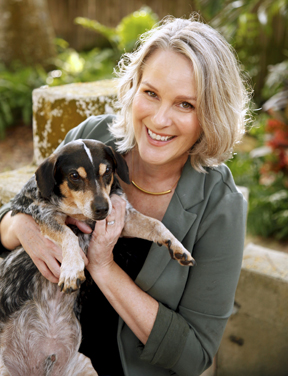Ariana Anderson

Photo by Taran Daly
"Every clinic has its own set of issues, but moving around makes those issues a lot less annoying," Dr. Ariana Anderson, who has been a relief veterinarian for about 10 years, told the VIN News Service. "I just go in and I'm appreciated, which is awesome, and I don't have to take those problems home."
Dr. Ariana Anderson's lifestyle has not been exactly conducive to the role of staff veterinarian. Since graduating from veterinary school in 2003, Anderson relocated from Washington state to Virginia, then to Alaska, back to Virginia and back to Alaska, all while raising and homeschooling three children with her U.S. Coast Guard husband.
She worked as a relief veterinarian for practical reasons. Now it's her preferred option. "I don't want to do anything else, because I control my schedule. The days I commit to work, I'm there the whole day, as long as it takes. But I can take time off to do vacations or make sure I'm home for children's activities."
Based in Juneau, Anderson provides general practice relief for a local clinic and works for one week most months in other towns in Alaska, as well as in Washington and Arizona. She has depended upon her husband, friends and babysitters to provide childcare for the kids, who range in age from 8 to 14.
During her early years doing relief work, sometimes called locum tenens (Latin for "to hold the place"), Anderson made her way without much professional support and few relief colleagues. That's changing. She said, "Now, it feels like one person after another is turning to relief."
A May poll of members of the Veterinary Information Network, an online community for the profession, revealed high interest in relief practice. Of 2,219 respondents to questions about their status since 2020, 7% said that they shifted to relief or were in the process of shifting. More than 14% said they seriously considered going from full- or part-time work to locum work. Another 31% said they daydreamed about making such a change.
The shift may yet be relatively small or occurring too recently to be captured by other measures. Data collected by the American Veterinary Medical Association hasn't shown a significant increase in relief veterinarians as a share of total veterinarians actively engaged in public or private practice. It's held steady at around 2% from 2007 through 2021, according to association numbers.
AVMA spokesperson Michael San Filippo offered this caveat: "Because this is self-reported data, it doesn't necessarily reflect the true number of relief vets out there." Trying to pin down whether the number of relief veterinarians is actually growing as a percentage of the total workforce is complicated by the fact that the rate of growth and number of practitioners in the United States is also hardly a settled matter.
One concrete sign of growing interest is that a number of online staffing services have sprung up in recent years to serve locum practitioners.
Relief veterinarians interviewed by the VIN News Service cited a variety of reasons that they and their colleagues are gravitating away from traditional employment. Top among them is the desire to improve personal well-being, as job dissatisfaction and burn-out plague the profession. Veterinarian shortages, too, are providing additional incentives. Locum tenens say they currently receive premium pay — sometimes double what they made on staff — and heaps of appreciation for just showing up and doing their job.
A path out of a toxic situation
Claudia Medina

Photo courtesy Dr. Claudia Medina
Shown on the beach at La Ventana on Mexico's Baja peninsula where she kitesurfs, Dr. Claudia Medina is a newly minted full-time relief veterinarian in Southern California. She plans to work hard for the next seven months, then pack up her dogs and kites for a two-month return to Baja in February.
Dr. Claudia Medina, who became a full-time relief veterinarian last month, can quickly reel off a host of reasons that she "quit corporate practice." An emergency veterinarian in Southern California, she felt overworked, underpaid, unappreciated and under-supported for several years — conditions that worsened during the Covid-19 pandemic.
"We got so overworked because there was an influx of so many pets, and a lot of general practitioners closed their shops for good," Medina said. "I was working 15-hour days at least for two years. I was like, 'This is not sustainable.' "
What stuck in her craw was how she was expected to stay after her 10-hour shift without being compensated for it. "It was the norm to be working for free," she said, adding that the practice owners didn't seem to care.
Exacerbating her consternation was the realization that relief doctors working alongside her were paid significantly more, while avoiding overtime and the stress and office politics that come with being on staff.
Medina shifted her schedule, splitting her time between two locations in her practice group in search of a better fit. She also dabbled in relief to supplement her income and see what it was like. At the same time, several of her ER colleagues shifted to locum work, and became ambassadors to the life and informal advisers.
Not everyone was supportive. "People were kind of, you know, putting fear into me," Medina said. "My supervisor was like, 'You're going to lose your 401(k), and you're going to have to get your own health insurance.' "
Medina said she was daunted by the details of going solo until she talked to a lawyer. He helped her transfer her 401(k) into a personal retirement account and pulled together her S corporation filing. She signed up for health and disability insurance and joined Roo, a four-year-old staffing service for relief veterinarians and veterinary technicians.
She said she's been called "brave" for giving up the security of a staff position, but seeing the countless relief job postings on Roo assuaged any concern about finding work. "The amount of shifts that are out there, it's insane," Medina said.
Now she's the relief veterinarian hearing from unhappy staff veterinarians. "Doctors that I've worked with say, 'I wish I could be doing what you're doing. I know you're getting paid more than me,' " she said. Medina is unmoved. She thinks of it this way: "You're right now telling me that you're miserable ... but you're not willing to do anything about it."
Many motivations for doing locum work
Cindy Trice

Photo courtesy of Dr. Cindy Trice
Dr. Cindy Trice, pictured with her dog Richard, founded an online service to support relief veterinarians like herself. She thinks of herself as a business-to-business provider. "The clinic is my client," she said. "My job is to support that pet parent's bond to the practice. Once I had that whole evolution in my head, I started to enjoy practice even more."
In recent years, Dr. Cindy Trice, a Florida-based relief veterinarian, has encountered many colleagues fed up with workplaces where they don't feel appreciated. In 2018, she founded Relief Rover, an online service that connects independent relief veterinarians with temporary openings at hospitals around the country. The service is free to veterinarians (2,800 are members on the site), who communicate directly with hospitals to book work, set fees and invoice. Employers pay a membership fee to post jobs and access profiles of participating veterinarians and veterinary technicians.
Trice said a growing number of those signing up for the service are like Medina.
"It's easy to start feeling taken advantage of, especially when you have too many days of work-ins and walk-ins on top of appointments. It wears on you," Trice said. "But when you're a relief vet, my experience has been, it is nothing but love and gratitude. You are the fun auntie."
Escape isn't the only reason veterinarians opt into locum work. Trice thinks of relief veterinarians as falling into four basic categories. In addition to escapers, there are those veterinarians, like herself, who seek out relief practice for autonomy, flexibility, variety and the opportunity to blend work with travel. Another group includes "people keeping their toe in": practitioners, former practice owners and veterinarians with day jobs in nonclinical settings who want to keep their skills sharp with occasional hands-on work.
This last group, Trice said, plays an important role now. "With our supply and demand being the way it is, we have so many pets that we need to care for, the more veterinary talent that we can bring back to the table to work in whatever capacity we can get them to work, we're going to help take care of those pets," she explained.
A fourth category, Trice said, is newer and growing. She calls them "shoppers." These are veterinarians who get into relief temporarily as a way to shop around for a practice where they want to stay long term.
Veterinarians, she said, "have lost trust in job postings full of promises" — like happy teams, great culture, the latest technology — followed by an interview process in which everyone is on their best behavior.
Relief work, she said, is a chance to see how a practice functions under real-world conditions without expectations of long-term employment on either side.
"I have started to think relief is the new talent acquisition," Trice said. "Talent-acquisition people need to stop thinking of relief vets as just these people who come in and put a Band-Aid on it for a little bit. They may actually be the right match, and it's a win on both sides."
Converting relief veterinarians to full-time employees is a common enough occurrence that placement services plan for it and charge hospitals a fee if one of their relief veterinarians is hired as the result of a gig. Fees can range from a couple hundred dollars to tens of thousands of dollars, according to Trice. (Relief Rover does not charge these fees.)
The diminishing rewards of loyalty
Andrew Findlaytor

Photo courtesy of Dr. Andrew Findlaytor
Dr. Andrew Findlaytor was a veterinary technician before going to veterinary school. He now works for a veterinary relief staffing service called Roo, where he's focused on supporting technicians as well as veterinarians in developing locum careers.
A year after graduating from veterinary school in 2015, Dr. Andrew Findlaytor threw himself into relief practice. He said he worked at everything from referral specialty centers to rural practices.
Findlaytor wanted to experience a wide range of medicine and practice management and he was on the lookout for a bigger prize.
"I was hoping by bouncing around and networking, I could find someone who wanted to sell their practice to a person and not to a corporation," Findlaytor said. "I never, ever found that magical person." He got close a couple of times but was outbid by consolidators in the final stretch.
Findlaytor's experience highlights one of the reasons he thinks veterinarians are gravitating toward relief. With practice ownership essentially off the table for most associates, he asks, what's the payoff for loyalty?
"If I come work for you four days a week, five days a week, for 30 years, if I give you the whole nine yards, what's waiting for me at the end?" Findlaytor said. "We don't have equity over time. There are no stock options. So in a supply-and-demand market, what is the incentive for someone to have loyalty and work 30 or 40 years, [when] at the end of it, it's just gonna be a pat on the back and 'thank you'?"
However, Findlaytor stresses there is no one reason veterinarians choose relief practice.
Today, Findlaytor works for Roo as director of veterinary strategy and services. He describes his role as helping veterinarians and veterinary technicians get paid better and have better work-life balance, while helping hospitals find the help they need. Practitioners on Roo are independent contractors who choose when and where they want to work. Roo sets minimum pay rates, manages bookings, collects payment and pays contractors within two business days. The service is free to veterinarians. Posting jobs is free for hospitals, but they are charged a service fee for completed bookings. Roo has more than 2,000 relief veterinarians in about a dozen states.
"We've got an amazing variety of people, all very skilled, but all with different motives," he said. The desire to reduce stress is something Findlaytor observes has strengthened since the pandemic. "We're seeing a lot of people prioritize, especially after Covid, what's most important to them," he said. Those priorities include not feeling guilty for taking time off.
During his short tenure as an associate, Findlaytor said, it was hard to take time off without feeling bad about leaving more work on colleagues' shoulders. Once he shifted to relief, he worked 10 months a year, leaving two for travel. He went to Japan and Hong Kong for an extended stay before the pandemic. "I didn't leave anyone high and dry," he said. "I didn't have to ask permission or beg and plead. That was my choice. And I enjoyed every second of it."
Relief as a long-term solution?
Michael Raphael, an animal health executive, views the role of relief veterinarians through the lens of a former owner of practices. In 2010, he co-founded Community Veterinary Partners, a consolidator of animal hospitals, and watched as it became increasingly difficult to hire and retain veterinarians.
"I definitely started to feel rising dissatisfaction among doctors," he said. "That dissatisfaction was about the way that they work, the hours they have to work, what they were being asked to do — weekends, nights — [and] not having a lot of control over their schedule."
He saw veterinarians leave the profession. "They were just walking out the door, and it wasn't to do another job," he said. "They just didn't want to do [veterinary medicine] anymore."
In 2017, Raphael, having left Community Veterinary Partners, launched IndeVets, a veterinary staffing company designed to address the exodus by combining the benefits of relief work with the stability of a staff position. IndeVets veterinarians (of which there are about 150 in 23 states) are employees of the company, not contractors. Raphael said salaries are set to match associate-level compensation or better and include benefits.
"I think that there's a little bit of a false analogy that relief doctors are pulling in more, because there's so much that comes with that job," Raphael said. "You have to find the practices. You have to bill. You have to invoice. You have to do the taxes and get your own benefits. You have to do all the legwork ... and there's no support."
IndeVets contractors choose when they work, where they work and the type of medicine they practice for a minimum of 34 hours a week, calculated on a quarterly basis.
"They have total control, and they can build a schedule that is 9 to 5, Monday through Friday," Raphael said. "If they want to work weekends, that's great. We have a doctor down in Maryland, and he has a Harley. And his idea is, you always schedule shifts 45 minutes away" so he can ride his motorcycle there. "That's his thing."
The model apparently works well for at least some clinics, too. "For some of our hospitals," Raphael said, "we're their entire staff."